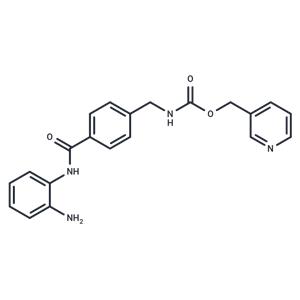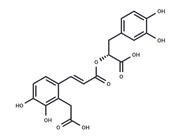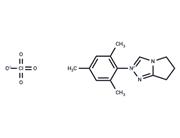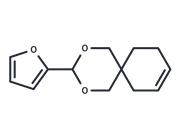| Name | Entinostat |
| Description | Entinostat (MS-275) is an HDAC class I selective inhibitor of HDAC1, HDAC2 and HDAC3 (IC50=243/453/248 nM) with oral activity. Entinostat has antitumor activity. |
| Cell Research | Cancer cells (5 × 10^3) were seeded into each well of 96-well plates and were cultured with graded concentrations of the drugs for 3 days. The cells were stained with 0.1 mg/ml neutral red for 1 h in a CO2-incubator, and, after aspiration of the medium, OD540 of the neutral red solubilized with 50 μl of ethanol and 150 μl of 0.1 M Na2HPO4 was measured. The IC50 value was determined by plotting growth inhibition of the cells against the logarithm of the drug concentration [2]. |
| Kinase Assay | The HDAC enzyme activity assay was done as described. Briefly, 40 μl HeLa cell nuclear extract, 29 μl enzyme buffer [15 mM Tris HCl pH 8.1, 0.25 mM EDTA, 250 mM NaCl, 10% (v/v) glycerol]; for recombinant HDAC isoenzymes, 0.1 mg/ml bovine serum albumin (BSA was added) and 1 μl compound were added per well of a microtiter plate. The reaction was started by addition of 30 μl substrate (Ac-NH-GGK(Ac)-AMC final 25 μM). After incubation for 90 min at 30°C, reaction was terminated by adding 25 μl stop solution (50 mM Tris HCl pH 8, 100 mM NaCl, 0.5 mg/ml trypsin, 2 μM TSA). After 40 min incubation at room temperature, fluorescence was measured using a Wallac Victor 1420 multilabel counter (Excitation 355 nm, Emission 460 nm). The HDAC1, 3, 6 and 8 assays were done with slight modifications. About 14 ng/well HDAC1, 2 ng/well HDAC3 or 10 ng/well HDAC6 were incubated with 6, 25 or 10 lM Ac-NH-GGK(Ac)-AMC, respectively, for 2 or 3 hr at 30°C. In contrast, 100 ng/well HDAC8 were incubated with 50 μM Ac-NH-RHK(Ac)K(Ac)-AMC for 3 hr at 30°C. Termination of the reaction and all further steps were done as described earlier for HeLa cell nuclear extracts. For the enzyme kinetic studies with HDAC1, selected HDAC inhibitor (around IC50 value), as well as Ac-NH-GGK(Ac)-AMC substrate (up to 100 μM) concentrations, were evaluated under standard conditions as described earlier [1]. |
| Animal Research | A2780 cells (9 × 10^6) grown in vitro were suspended in PBS and were injected subcutaneously into the flank of nude mouse. For the other tumor lines, KB-3-1, HCT-15, 4-1St, Calu-3, St-4, Capan-1, and HT-29, tumors were passaged several times before starting in vivo antitumor testing, and a tumor lump (2–3 mm in diameter) was transplanted subcutaneously into the flank of a nude mouse by using a trocar needle. Treatment (four or five mice in each experimental group) with the drugs was started after the tumors were confirmed to have grown in the body (tumor size, 20–100 mm3). MS-27-275 and compound 2, both dissolved with 0.05 N HCl, 0.1% Tween 80, and 5-fluorouracil (5-FU) and diluted with physiological saline, were administered orally once daily 5 days per week for 4 weeks. Tumor length and width were monitored twice weekly, and tumor volume was calculated as described [2]. |
| In vitro | METHODS: A variety of tumor cells were treated with Entinostat for 72 h, and cell viability was measured by Resazurin solution.
RESULTS: Entinostat inhibited tumor cell proliferation with an average IC50 of 2.57 µM.[1]
METHODS: Human pancreatic cancer cells PANC-1 and SUIT2 Clone 1 were treated with Entinostat (1-50 µM) for 72 h. The expression levels of target proteins were measured by Western Blot.
RESULTS: Entinostat caused a dose-dependent increase in cellular histone H3 acetylation and had no effect on total histone H3 protein levels, confirming that Entinostat inhibits the deacetylation activity of HDAC in cancer cell lines. [2] |
| In vivo | METHODS: To assay antitumor activity in vivo, Entinostat (12.5-49 mg/kg, 0.05 N HCl+0.1% Tween 80) was administered orally to nude mice bearing human tumor xenografts five times per week for four weeks.
RESULTS: Entinostat at 49 mg/kg showed significant antitumor effects against KB-3-1, 4-1St, and St-4 tumor lines, and moderate effects against Capan-1 tumors. 24.5 mg/kg and 12.3 mg/kg also showed significant effects against these tumors. The dose of 24.5 mg/kg was also effective against A2780 and HT-29 and moderately effective against Calu-3. [3] |
| Storage | store at low temperature,keep away from moisture,keep away from direct sunlight | Powder: -20°C for 3 years | In solvent: -80°C for 1 year | Shipping with blue ice/Shipping at ambient temperature. |
| Solubility Information | DMSO : 237.5 mg/mL (630.96 mM), Sonication is recommended.
10% DMSO+40% PEG300+5% Tween 80+45% Saline : 3.77 mg/mL (10.02 mM), Solution.
|
| Keywords | SNDX275 | SNDX 275 | MS275 | MS 275 | Inhibitor | inhibit | Histone deacetylases | HDAC3 | HDAC1 | HDAC | Entinostat | Autophagy | Apoptosis |
| Inhibitors Related | Stavudine | Cysteamine hydrochloride | Sodium 4-phenylbutyrate | Hydroxychloroquine | Guanidine hydrochloride | Tributyrin | Paeonol | Naringin | L-Ascorbic acid sodium salt | Alginic acid | Gefitinib | Dextran sulfate sodium salt (MW 5000) |
| Related Compound Libraries | Anti-Lung Cancer Compound Library | Failed Clinical Trials Compound Library | Bioactive Compound Library | Anti-Cancer Clinical Compound Library | Drug Repurposing Compound Library | Inhibitor Library | Anti-Cancer Approved Drug Library | Orally Active Compound Library | Anti-Aging Compound Library | Bioactive Compounds Library Max | Anti-Cancer Drug Library | Anti-Cancer Active Compound Library |

 United States
United States






